Silver Nickel Vine
Description
A creeping and trailing native plant with spectacular, silvery fan shaped foliage; easy to grow and great for containers, hanging baskets, spilling over walls, or as a groundcover
Landscape Attributes
Silver Nickel Vine is an herbaceous annual with a trailing habit of growth, eventually spilling over the edges of hanging baskets and containers. It brings an extremely fine and delicate texture to the garden composition and should be used to full effect.
Silver Nickel Vine is recommended for the following landscape applications;
Planting & Growing
Silver Nickel Vine will grow to be only 3 inches tall at maturity, with a spread of 4 feet. Its foliage tends to remain low and dense right to the ground. Although it's not a true annual, this fast-growing plant can be expected to behave as an annual in our climate if left outdoors over the winter, usually needing replacement the following year. As such, gardeners should take into consideration that it will perform differently than it would in its native habitat.
This plant does best in full sun to partial shade. It prefers dry to average moisture levels with very well-drained soil, and will often die in standing water. It is considered to be drought-tolerant, and thus makes an ideal choice for a low-water garden or xeriscape application. It is not particular as to soil pH, but grows best in sandy soils, and is able to handle environmental salt. It is highly tolerant of urban pollution and will even thrive in inner city environments. This species is native to parts of North America. It can be propagated by cuttings.
Silver Nickel Vine is a fine choice for the garden, but it is also a good selection for planting in outdoor containers and hanging baskets. Because of its trailing habit of growth, it is ideally suited for use as a 'spiller' in the 'spiller-thriller-filler' container combination; plant it near the edges where it can spill gracefully over the pot. Note that when growing plants in outdoor containers and baskets, they may require more frequent waterings than they would in the yard or garden.

